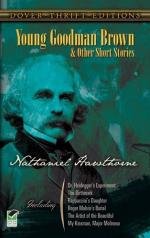|
This section contains 906 words (approx. 4 pages at 300 words per page) |

|
Young Goodman Brown's Nocturne
Summary: As with all of his works, Nathaniel Hawthorne incorporated symbolism, particularly religious symbolism, as a primary literary device in his short story "Young Goodman Brown." Hawthorne's symbolic usage of the traveler's snake staff, the dark forest, and the townspeople of Salem Village make Goodman Brown's dream an allegory of Brown's paranoia of what is possible when people he knows and trusts reject God and turn to sin.
Nathaniel Hawthorne's short-story, "Young Goodman Brown" is a tale of a man losing his faith in God and humanity after experiencing a startling dream in which he witnesses the people of Salem attending a nefarious congregation led by Satan himself. As with all of Hawthorne's works, symbolism is a primary literary device in the story. The majority of, and the most prominent and important symbols in the narrative are of the religious variety. Essential to the story of "Young Goodman Brown" are the symbolic usages of the traveler's snake staff, the dark forest, and the townspeople of Salem Village. Together, these three symbols are used by Hawthorne to make Goodman Brown's dream an allegory of Brown's paranoia of what is possible when people he knows and trusts reject God and turn to sin.
The symbol of the traveler and the snake-shaped staff which he carries are representative of...
|
This section contains 906 words (approx. 4 pages at 300 words per page) |

|


